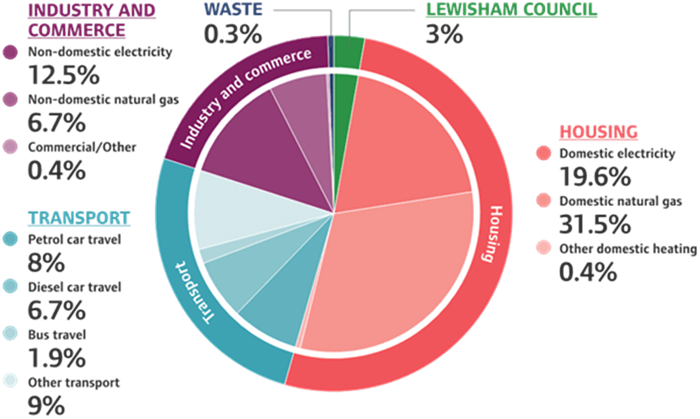Carbon emissions reporting
To help us reach net zero carbon by 2030, we are producing annual carbon emissions reports on the current level and source of carbon emissions for Lewisham Council. While these currently show Council-wide only emissions, it is our ambition to ultimately report on borough-wide emissions as well.
The data used to establish Lewisham’s carbon emissions baseline was released by the Department of Business Energy and Industrial Strategy on Thursday 27 June 2019. This data shows carbon dioxide emissions in Lewisham were down by 38% since 2005. This data was used to make a plan to reach net zero carbon by 2030.
Lewisham’s carbon emissions baseline

| Cause of carbon emissions | Percentage of total carbon emissions |
|---|---|
| Domestic natural gas | 31.5% |
| Domestic electricity | 19.6% |
| Non-domestic electricity | 12.5% |
| Other transport | 9% |
| Petrol car travel | 8% |
| Diesel car travel | 6.7% |
| Non-domestic natural gas | 6.7% |
| Lewisham Council | 3% |
| Bus travel | 1.9% |
| Commercial/other | 0.4% |
| Other domestic heating | 0.4% |
| Waste | 0.3% |
Half the borough’s carbon emissions come from energy used within people’s homes.
The remaining half is split between transport and business. Transport emissions include all vehicles travelling in or through the borough.
Our operations are responsible for 3% of the borough’s total carbon emissions. This includes:
- energy use in our buildings, including offices, schools, libraries and leisure centres
- carbon emissions arising from our fleet
Lewisham corporate carbon emissions reporting
The title of our report on our carbon emissions is ‘Use of Resources 2020/21’.The report covers Lewisham Council corporate carbon emissions: corporate buildings in operational control of the council, LA-maintained schools, street lighting and fuel use for the council fleet.
This title represents an ambition to expand what is reported on to include the embedded emissions of our wider-resource use and for the whole borough, including by measuring the emissions from waste and recycling. We do not currently have the data to be able to fully measure our resource use but this remains an ambition.
- Lewisham Council Corporate Carbon Emissions Report 2020/21
- Lewisham Council Corporate Carbon Emissions Report 2022/23
- Lewisham Council Corporate Carbon Emissions Report 2023/24
Lewisham Strategic Partnership corporate carbon emission reporting
The Lewisham Strategic Partnership is a network of Lewisham-based institutions working together to make Lewisham a better place. Climate emergency was identified as one of four strategic priorities for the Partnership and a climate sub-group was established early in 2023.
A Common Commitment on Corporate Carbon Emissions agreed by the LSP partners:
Lewisham’s Strategic Partnership Climate Subgroup recognises the importance of reporting corporate carbon emissions and encourages all organisations in the borough across the public, private and community sector to measure and report their emissions. As individual organisations and collectively we commit to continuing to report our emissions and to actively adopt good practice to extend the scope of this work.
The report below combines corporate carbon emission data from as many of the partners as possible for the period 2018/19 to 2022/23.1 Alongside corporate carbon emission data the report also includes emission data for residential sites owned by Lewisham Council, Phoenix Community Housing and University of London Goldsmiths.